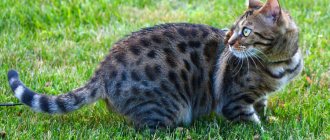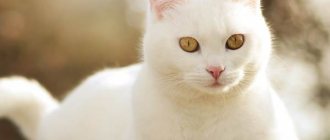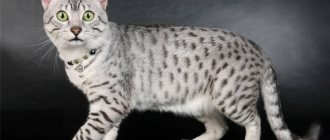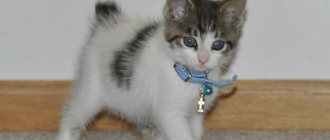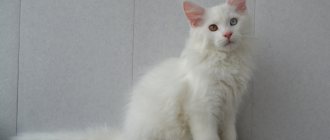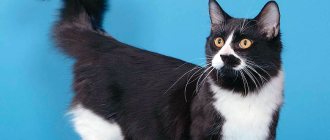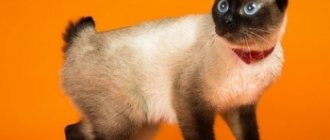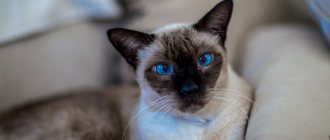History of the Exotic Shorthair cat breed
Exotic Shorthair cat
The appearance of the Exotic Shorthair breed dates back to the 50s of the last century. Frankly speaking, the first kittens appeared completely by accident. Wanting to get new coat colors and eye colors, American Shorthair breeders crossed their pets with Persian cats. Another goal of these attempts was to make the physique of “American women” more dense. The task was not solved. The offspring, to the surprise and disappointment of the breeders, turned out to be very “Persian” - all the animals were born with characteristic “doll” faces. And in other respects, the kids were more like their parents “from the East.” Only the fur became noticeably shorter and acquired a denser, plush structure. As a result of crossing, it was not possible to improve the American Shorthair cat breed, but completely new kittens with an outlandish appearance were born.
Already in 1966, Jane Martink introduced a new breed, which was given the name “Exotic Shorthair”. The accidentally bred cats took a long time to achieve recognition. Ambitious people were critical of “exotics”, believing that they encroached on the purity of this breed. It got to the point that they refused to mate their elite pets with exotic shorthairs, and they did this consciously and in an organized manner. Fortunately, there were far-sighted owners of the “Persians” who saw the prospects and took part in the selection. Among them, special mention should be made of Doris Walkinstick and Caroline Bussey, whose merits in the formation of a new breed can hardly be overestimated.
Representatives of the Russian Blue breed and Burmese cats were also used in breeding work. The experiments were stopped only when the shorthair gene was firmly established. Since then, matings of exotics have been possible only with Persians.
In 1990, felinologists came to an agreement that the breed standard completely duplicates all the requirements for the Persian cat, with the exception of the length and quality of the coat. Based on these agreements, all changes that are made to the Persian breed standard automatically become relevant for the exotic shorthair cat.
Features of shorthaired exotics
Short-haired representatives of the breed were obtained in the 60s of the 19th century.
As a result of crossing, a Persian and an American shorthair produced a cat very similar to the British cat. The structure and body structure of the British and exotic cats are very similar. But the character is different. The British are less active in games and are not as affectionate in temperament. The nose of the exotic is flattened. Short-haired cats require minimal care. They are very clean and can handle cleaning their undercoat on their own. In some cases, owners only need to massage the fur coat occasionally, about once every two weeks, with a special comb. This is necessary not only to give a gloss to the surface, but also serves as an excellent massage, helping to improve the animal’s blood circulation.
Short-haired cats are very pleasant to the touch. Although their coat is not fluffy, it is very bright and soft. Accordingly, there will not be much fur from such pets in the house, although during the molting period they also shed all excess.
Exotic appearance
Exotic kitten
The ideal exotic shorthair cat looks like a well-balanced animal with strong, even somewhat heavy bones. The coat gives the outline softness and roundness, the expression of the muzzle conveys complacency and calmness of character.
Head
Round in shape, quite massive. The skull is very wide with a round bone structure. The chin is well developed and round in shape. The jaws are strong and wide, the cheeks are full.
Eyes
The eyes of an exotic cat are located far from each other at the same level. The shape is large and round.
Ears
Small size, round shape. Set wide and low on the head, slightly tilted forward. Not very open at the base.
Nose
Wide, short and upturned. “Stop” is located clearly between the eyes.
Exotic cat face
Body
The body of exotics is medium or closer to large in size. Squat, with well-developed muscles, without signs of obesity. The chest is wide, the shoulders are massive.
Limbs
Exotic standing on his hind legs
Strong, short, massive. The front ones are straight, the rear ones are straight when viewed from behind.
Paws
Exotic paws are large and round. There are 5 toes on the front paws, 4 on the hind paws.
Tail
Proportional to body length, although it can rather be defined as short. No bends. The animal is held at a level below the back.
Wool
The exotic cat's coat is thick and plush, with a rich undercoat. Middle length. It feels very soft to the touch.
Disqualifying features
Visible weakness of the hind limbs, tail defects, number of toes that does not meet the standard. Strabismus, asymmetry of the muzzle or head. Visible deformities of the spine. White toes and non-blue eyes for color points.
Exotic photo
Character of an exotic cat
The character of the exotic shorthair is in amazing harmony with her charming appearance. Friendliness, calmness and complaisance make this animal a wonderful friend and companion. Pets are capable of sincere affection for their owner, but they show their feelings so delicately and subtly that they cannot be called intrusive. They will wait patiently until you finish your business, and only then will they remind you of their presence with a gentle, calm purr. Don't forget to give your friend enough time, because these cats can hardly tolerate loneliness.
With such a “cartoonish” and even somewhat clumsy appearance, exotics are quite active, inquisitive and agile. Moreover, showing natural curiosity, cats of this breed are able to lose their sense of danger. To avoid unpleasant or risky situations, try not to leave your pet alone for a long time. Both kittens and adult animals are playful. Many owners of exotic cats also note that they have well-expressed hunting instincts.
Adaptation of exotics to new conditions due to their livable nature does not present any particular difficulties. Your household, as well as pets already living in the house, will easily find a common language with this cute creature if they are in a positive mood.
Exotic shorthair cats have virtually no manifestations of aggression - in order to bring them out of a state of mental balance and serenity, you need to really want it. The manifestation of hostility, and even then in the form of attempts to avoid close contact, is possible only towards strangers.
Relationships with younger family members almost always go well. Exotics themselves love to play and will gladly take part in children's fun. All you have to do is control the degree of activity and safety of the game on the part of the “human cubs”.
From the point of view of a combination of character traits, temperament and intelligence, the Exotic Shorthair can rightfully be considered a cat ideal for home keeping.
White exotic nestled on the sofa
Interesting Facts
Here are some interesting facts about these amazing animals that need to be brought to life:
- Kittens, and even adults, love to have a personal space where they can relax and play at the same time. For these purposes, it is advisable for the owner to purchase a cat house in which the pet can sleep on a soft surface and sharpen its claws on some rough surface.
- Long-haired exotics really like to sleep on a cold tile or on a windowsill. This is due to the fact that due to their abundant undercoat they often get very hot. But due to the fact that their health may deteriorate, they should not be allowed to do this for a long time.
- During the absence of the owner of the house, the cat should be busy with something. To do this, he needs to purchase a soft toy or fluffy trinket. If this is not done, furniture and wallpaper may be damaged.
- They don’t really need walks with cats, but sometimes you can try to take your pets out to bask in the sun. You need to get used to regular outings from childhood, otherwise an unexpected walk may not appeal to the exotic. If the kitten is accustomed to walking, then there is no need to be afraid that it will run away. Exotics will not leave their owner, they will only find a secluded, deserted place where they can calmly relax and breathe fresh air.
Education and training
Red bun
The Exotic Shorthair cat is very intelligent, perceptive and trainable. Practice has shown that exotics are able to remember simple commands and prohibiting words. To achieve lasting results, it makes sense to start training from the day you bring the kitten into the house. To make it easier to learn the simplest commands, you can accompany them with short exclamations or simply clap your hands.
The main rule of training is no aggression. The psyche of exotic cats is very sensitive, so you won’t find a better training method than love and patience. By forcing an exotic kitten to do anything through force, threats and intimidation, you will not only permanently lose his trust, but also cause serious harm to the baby's health.
Educational moments—training a kitten to use a litter box and a scratching post—usually pass without much difficulty. It is better to place the toilet in a quiet place where no one will distract your pet from his business. And so that your baby quickly understands the purpose of the scratching post, try spraying it with valerian tincture or a special product purchased at a pet store.
Hybrid breeds
During breeding work, several more breeds of cats with short tails were developed.
Pixiebob
The result of crossing a wild lynx and a short-haired cat. Animals are highly talkative, so you need to be prepared for constant rumbling, purring and chattering under the ear. Cats love to be the center of attention and follow their owner wherever he goes and whatever he does. They feel great outside the home, going with the family on picnics or long journeys. They can walk on a leash and follow some commands. Pixiebobs have high intelligence, which gives them a head start in many games - both active and static. They get along well with children, but you need to make sure that they treat the cat with due respect and do not offend it.
On average, animals live 13-15 years and have no predisposition to hereditary diseases.
Care and maintenance
The exotic shorthair cat is an absolutely unpretentious creature. Professional grooming is not required, which is why representatives of the breed are sometimes called “Persians for the lazy.” But this does not mean that you don’t need to take care of your fur coat. The coat of exotics is very thick, voluminous, soft and well balanced with a soft undercoat. To keep the coat looking healthy and beautiful, you should comb it two to three times a week using a special high-quality metal comb. Like other felines, exotic shorthaired cats take care of their appearance by licking themselves, which is why experts recommend having a means to remove hairballs from the stomach in your veterinary medicine cabinet.
Combing an exotic's fur
Exotics need systematic bathing, at least once a month. The structural features of the animal's face require careful and attentive care - wipe it daily with a damp cloth, paying special attention to the condition of the eyes and tear ducts, as well as the cat's nose. Don't forget to trim your pet's nails twice a month using a safe nail clipper. It is unnecessary to remind you about the mandatory presence of a scratching post.
Provide your pet with a comfortable, safe place where he can rest peacefully. If this is a house, then purchase it in such a way that the animal has enough space to lie down, curled up in a ball or stretched out to its full length. Move your exotic cat closer to you - the pet does not tolerate loneliness well. Some representatives of the breed love to sit or lie for long periods of time on cool surfaces, such as tile floors. To prevent your animal from catching a cold, try to limit the time of these “cooling” procedures.
Om-Nom-nom
If you do not live on the ground floor, make sure there are protective nets on the windows. Exotic shorthairs are large animals, in some ways even obese, and a fall from a height can lead to the most severe consequences.
When deciding on nutrition, remember that adult animals are prone to obesity. To avoid such problems, teach your pet a proper, balanced diet from an early age. Immediately put a taboo on fatty foods and goodies from the common table. The diet should be based on protein products in organic combination with cereals, vegetables and vitamin complexes. The use of premium dry ready-made food from leading manufacturers is completely acceptable.
Important: if you use both dry food and natural products, never combine them. You can alternate, but you can mix – no!
Origin story
The domestic cat is a companion animal that has lived alongside humans for over ten thousand years.
The first wave of its spread around the world occurred with the emergence of agriculture, twelve thousand years ago, mainly in the Middle East. The second contributed to the settlement of cats that migrated with humans from Egypt to Europe and North Africa.
The first wild animal, from which our pets originated, appeared on the planet more than 130 thousand years ago. This is a steppe cat that still lives in Africa.
The first pets most likely appeared in Anatolia - the territory of modern Turkey. Their appearance near humans is associated with the development of agriculture, the availability of food in sufficient quantities and the need to protect supplies from rodents and small predators. It was from the east that the companion animal came to Cyprus and Ancient Egypt.
Scientists have differing opinions about whether cats are fully domesticated animals or not. This independent animal is capable of returning to the wild at any time. Unlike the dog, which lost its hunting skills during evolution, the blood of the ancient ancestors in the cat is very strong.
This is a friend, companion, and sometimes assistant and protector, he simply lives nearby and allows himself to be loved. Whether a person has tamed a cat or whether it has taken his heart and soul and holds it in her tender claws is a difficult question.
Over centuries of coexistence, people deified and worshiped the cat. And now they continue to serve her. However, these smartest creatures respond to people with no less love and affection.
Initially, starting with the wild steppe cat, these animals were only short-haired. The long hair of many breeds is the result of natural or artificial mutations.
But many representatives of the cat world today are short-haired and delight the aesthetic sense with their shiny coat of various quality and colors.
Read the article about the forest cat, the true ancestor of our domestic cats.
Health and disease of the exotic shorthair cat
Black Exotic
Exotic Shorthair is an artificially bred breed, which in essence is no different from its relatives - the Persians (except for the length and structure of the coat). It is absolutely logical that the genetic diseases in these two breeds are almost identical.
The most common diseases of the respiratory system and eyes occur in exotic animals. The reason is obvious - the unusual structure of the muzzle and the associated deformation of the nasolacrimal duct.
A genetic predisposition to kidney disease and cardiomyopathy is clearly visible. The latter disease very often causes the death of animals of this breed at an early age.
The oral cavity of the exotic can also be considered a risk zone, and a fairly high one at that. Without proper care of your gums and teeth, gingivitis, periodontal disease and other inflammatory diseases may occur. Sometimes cats have abnormally developed lower jaws, which can lead to problems eating.
The best prevention of the occurrence or complex course of these and other diseases is proper care and careful monitoring of your pet’s condition. Timely vaccination, deworming, preventive examinations at a veterinary clinic - all these simple measures will help you avoid unnecessary problems and maintain the health of your exotic shorthair cat for many years.
Artificial food
Each owner decides for himself what to feed the exotic. But most breeders agree that for cats of this breed it is preferable to eat artificial food, which provides the most favorable ratio of essential vitamins and microelements. When choosing food, follow the basic recommendations of breeders:
- The food should be at least premium class, since cheap brands contain too many spices and salt. Be sure to pay attention to the fact that it is intended for an exotic animal of a suitable age, and study the composition.
- Continue feeding the food chosen by the breeder. An exotic cat does not respond well to changes in diet.
- Do not overfeed the animal, otherwise problems with excess weight will arise.
- If you are obese, you need to change food to a special one to stabilize your weight.
How to choose a kitten
Exotic cat
Life shows that in most cases we buy a cat “for the home, for the family,” so personal sympathy often becomes the main selection criterion. If you are planning to buy an exotic cat to participate in exhibitions or want to seriously engage in breeding, then the selection criteria will be much stricter - it must be a breed or show class kitten, from titled parents with the appropriate documents.
However, in both cases, you must carefully evaluate the external indicators of the baby’s health: feel the tummy, look in the ears, mouth and even under the animal’s tail. It is useful to observe the behavior of your chosen one for some time in order to make at least rough assumptions about his temperament.
You should know that the combination of certain signs in kittens of an exotic breed may indicate the presence of genetic problems. For example, a blue-eyed white creature with a high degree of probability may suffer from hearing loss, or even be completely deaf.
We do not recommend buying a baby who is not yet 3-3.5 months old. By this age, as a rule, breeders have completed the first scheduled vaccination, including the period of mandatory post-vaccination quarantine. Kittens at this age already have certain hygiene skills, and their gastrointestinal tract is ready for the transition from mother's milk to “adult food”.
Before buying an exotic, you should familiarize yourself with the characteristics of the breed, all its pros and cons, in order to make the right choice.
Eyes and nose - "Achilles' heel"
Persians and exotics have one specific problem. Due to the small nose and the special structure of the nasopharynx and tear ducts, these cats’ eyes can be constantly dirty - the discharge can be transparent or dark brown, the so-called “ black tears”
».
You cannot wash your cat with water! You just need to wipe the corners of his eyes with a dry cloth
.
If you think that the problem is excessive, show the animal to the veterinarian, he can prescribe drops, but there is no need to constantly put it in the Persians’ eyes!
also catch colds easily.
– they have a runny nose, which clogs the nasopharynx and prevents the cat from distinguishing the smell of food. If a cat often snorts, sniffles, “does not see” and does not even want to eat its favorite food, it may have a cold! To prevent this from happening, protect your pet from drafts!
But in general, the myth about the difficulties of care
that a Persian cat will require is greatly exaggerated - all other care is standard, and the procedures described above will take a maximum of half an hour a day!
—— Author – Dasha Blinova, website www.sympaty.net – Beautiful and Successful Copying of this article is prohibited!
Photos of exotic kittens
How much does an exotic cat cost?
The price of an exotic kitten depends on several factors. These include:
- compliance with the breed standard;
- “purity of blood” - the more elite the parents, the more expensive the kittens;
- color, its rarity and fashionability;
- routine vaccination carried out.
Prices in professional nurseries are objectively higher than those of private breeders. You can buy exotics even cheaper online or at the poultry market. Although in the latter case, a certain cheapness is more than compensated for by the possible numerous risks. There are even known cases of selling a simply cut Persian kitten instead of an exotic shorthair.
We recommend contacting trusted breeders or nurseries, where the average price of an exotic shorthair kitten, depending on the class, can range from 7,000 to 50,000 rubles.

